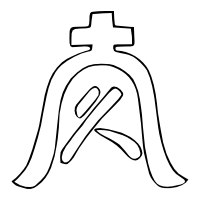Recreational research into Feudal Japan
Mon of the Week: Bell
Today we look at another mon from the same collection of provincial samurai mon from the 15th century.(KJ:7) Today’s mon uses an enclosure that didn’t become a common element in Japanese mon despite its simplicity and elegance.
The enclosing shape appears to be a bell. Bells were associated with Buddhist temples, which used large bells to announce times for prayers, meals, and other such scheduled events in much the same way as Western churches and monasteries. These bells are struck from the outside by thick hanging wooden poles, instead of having an internal ringer and moving the bell itself with ropes.Watch movie online John Wick: Chapter 2 (2017)
The character inside is slightly mysterious despite being clearly drawn. It’s most probably a variation on 久, meaning ‘long time’, which in addition to being used in the Japanese equivalent of “long time no see” (久しぶり/hisashiburi) also has auspicious connotations of longevity.
While cross-like elements like the one present here would later be common in the mon of “secret Christians” (Kakure Kirishitan) after Christianity was outlawed in Japan, this particular mon predates such things. Here it perhaps represents a ring hanging the bell from a beam.
Similar bells would also be used as fire bells in the Edo period,(ja.wp:半鐘) when the population density and wooden construction in Edo caused frequent fires. In the peace of the Edo period, some warriors turned to serving in fire brigades summoned by such bells. More realistic, three-dimensional depictions of these bells are used in mon today.(Dower:105)
As a side note, a supposed veiled insult engraved on a temple bell is supposed to have triggered the Ōsaka Campaign,(en.wp:Bell_(instrument)) which is one good source of depictions of military mon.
Comments are closed.

